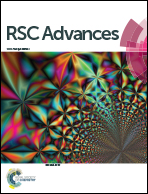Dipicolylamine coupled rhodamine dyes: new clefts for highly selective naked eye sensing of Cu2+ and CN− ions†
Abstract
The dipicolylamine (DPA) motif which is known as a binder of Zn(II) ions, has been utilized in devising rhodamine labelled compounds 1 and 2. Compound 1 acts as a FRET sensor and shows excellent selectivity for Cu(II) ions over a series of other cations in CH3CN/H2O by exhibiting a colour change (colourless to pink) of the solution. The spectral and colour changes are recovered in the presence of CN− ions and thus, the ensemble 1·Cu2+ in CH3CN/H2O is established as the medium for selective detection of CN− ions. In contrast, the modified compound 2 with the dipicolylamine motif as the principal binding site has been established as the colorimetric sensor of Cu(II) ions and the fluorometric sensor of Hg(II), Zn(II) and Cd(II) ions. Both the compounds 1 and 2 are cell permeable and are successfully employed for the detection of intercellular metal ions through bright field and fluorescence imaging.


 Please wait while we load your content...
Please wait while we load your content...